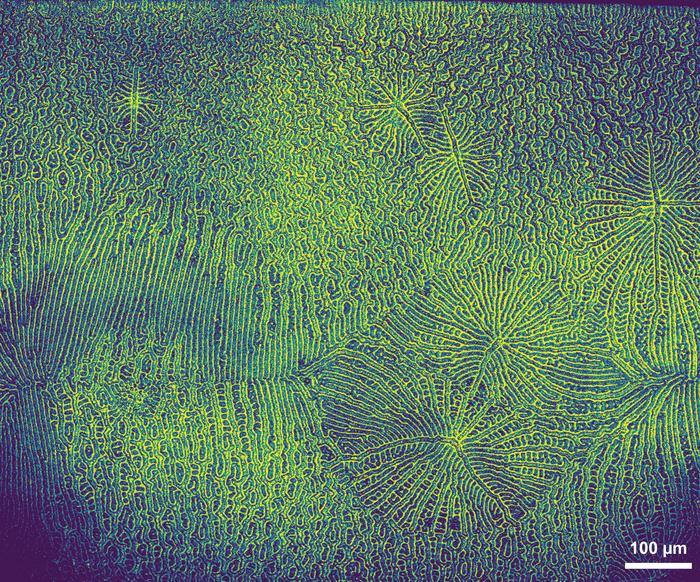Researchers at the University of Cambridge and the Eindhoven University of Technology have made groundbreaking advancements in the realm of organic semiconductors, overcoming longstanding challenges and opening new avenues for technological innovation. This significant research centers around the development of an organic semiconductor that compels electrons to travel in a spiral trajectory, a remarkable refinement that holds the promise of revolutionizing the efficiency of OLED displays as well as paving the way for next-gen computing technologies, such as spintronics and quantum computing.
The essence of this novel semiconductor lies in its ability to emit circularly polarized light, a trait that enables the transfer of information regarding the “handedness” of electrons. In contrast to traditional inorganic semiconductors, such as silicon, which exhibit symmetrical properties leading to non-directional electron movement, this innovative semiconductor harnesses the chiral characteristics of molecules. Chiral molecules, which can be thought of as mirror images, are prevalent in nature and play crucial roles in biological processes like DNA synthesis. Yet, leveraging this chirality within electronics has historically posed a challenge.
Through the integration of biophilic design principles into molecular architecture, the researchers succeeded in crafting a chiral semiconductor. This was accomplished by guiding stacks of semiconducting molecules to organize into either right-handed or left-handed spiral configurations. The findings from their research have been published in the prestigious journal Science, showcasing not just a notable academic achievement but also an important milestone for future technology.
One of the most promising applications for these chiral semiconductors is their use in display technology. Current display screens are notorious for wasting energy due to inefficiencies in light filtering processes. The chiral semiconductor introduced by these researchers naturally generates light in an orientation that could significantly mitigate such losses, thereby enhancing screen brightness and energy efficiency. This leap forward has profound implications, particularly as the demand for more sustainable technologies continues to grow.
Professor Sir Richard Friend, who collaborated in leading this innovative research from Cambridge’s Cavendish Laboratory, recounted, “When I began my journey with organic semiconductors, many remained skeptical about their potential. However, it is undeniable that they now form the backbone of display technology.” Highlighting the versatility of molecular materials, he likened the freedom to design unique structures to working with a limitless set of building blocks—a stark contrast to the constraints often imposed by rigid inorganic counterparts.
At the heart of this new semiconductor lies a material called triazatruxene (TAT), which self-assembles into a helical configuration, subsequently allowing electrons to spiral effectively along its structure. When stimulated by blue or ultraviolet light, this arrangement causes TAT to emit bright green light, characterized by strong circular polarization. Achieving such an effect in semiconductors had been a formidable challenge until this recent breakthrough, as articulated by Marco Preuss, co-first author from the Eindhoven University of Technology.
Through innovative adaptations in OLED fabrication techniques, the research team successfully integrated TAT into functional circularly polarized OLEDs (CP-OLEDs). These cutting-edge devices exhibited record levels of efficiency, brightness, and polarization, setting a new benchmark in the field. Co-first author Rituparno Chowdhury remarked, “By reengineering the conventional process for manufacturing OLEDs as we employ in smartphones, we’ve discovered a practical method for trapping a stable chiral structure within a non-crystallizing matrix.”
This research is culminative of a prolonged partnership between Sir Richard Friend’s research group and the team of Professor Bert Meijer from the Eindhoven University of Technology. Meijer commented on the significance of their collaboration by stating, “This breakthrough in developing a chiral semiconductor illustrates our meticulous approach to molecular design. We have successfully linked the chirality of our molecular structure to the electrons’ movement—a feat never previously accomplished on this scale.”
The implications of these chiral semiconductors extend far beyond display technologies. Envisioning a future driven by efficient quantum computing and advanced spintronics, these organic materials represent a crucial step forward in evolving electronic mechanisms. Within the growing $60 billion industry of organic semiconductors, this development signifies a turning point that may enhance not only the way we interact with technologies but also how we harness and process information.
Moreover, the work received substantial support from initiatives including the European Union’s Marie Curie Training Network and the European Research Council. Aided by this backing, the researchers are optimistic about tackling the forthcoming challenges and barriers that lie ahead in this rapidly advancing field.
This remarkable research, encapsulating years of collaboration and dedicated inquiry, has not only contributed to a burgeoning field of study but has also provided the scientific community with fresh insights into organic electronics. As the quest for optimizing performance and sustainability in electronic devices continues, this chiral semiconductor promises to be at the forefront of innovation, rooting its significance deeply in the evolution of future technologies.
In summary, this innovative leap in the domain of organic semiconductors enriches our understanding of electronics, presenting exciting potential for the future. By leveraging the intricate properties of molecular chirality, researchers are setting the stage for advanced applications that could redefine our approach to electronics and information technology, heralding in a new era characterized by efficiency and effectiveness.
Subject of Research: Chiral Semiconductors
Article Title: Circularly polarized electroluminescence from chiral supramolecular semiconductor thin films
News Publication Date: 14-Mar-2025
Web References: DOI Link
References: Science Journal
Image Credits: Samarpita Sen/Rituparno Chowdhury
Keywords
Organic semiconductors, display technology, light emitting diodes, molecular electronics, quantum computing, spintronics, semiconductors.
Tags: biophilic design in electronicschiral molecules in electronicsCircularly polarized lightelectron spiral trajectorynext-generation computing technologiesOLED display efficiencyorganic semiconductorsovercoming semiconductor challengesquantum computing innovationspintronics advancementstwisted light technologyUniversity of Cambridge research





